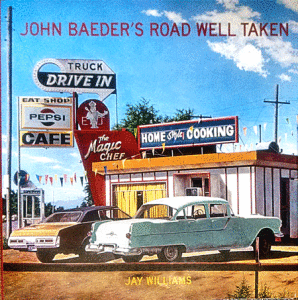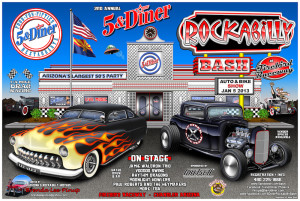“John Baeder’s Road Well Taken,” by Jay Williams, Vendome Press, 272 pages, 300 color and b&w illustrations, 2015. 978-0865653191. Hard cover $45
 John Baeder is legendary among roadside architecture enthusiasts for Diners,” his book of photorealistic diner paintings that turned out to be one of the most culturally influential publications of the 1970s.
John Baeder is legendary among roadside architecture enthusiasts for Diners,” his book of photorealistic diner paintings that turned out to be one of the most culturally influential publications of the 1970s.
Baeder, the subject of a new biography by art historian and curator Jay Williams, appreciated 20th century roadsides and the buildings that populated them before they became old, when they were just ugly rather than a source of popular nostalgia.
In fact, it was Baeder’s book that
helped spark the revival of interest in diners and their roadside settings. He began painting them just as they were beginning to disappear, worn-out dives giving way to theme restaurants and national fast-food chains. His meticulous capture of their images represented a kind of preservation in itself, documenting an architecture too recent to be much valued at the time. The diner renaissance those images fueled helped save many of the actual buildings from the scrapheap. If preservation was accompanied by nostalgic excess and commercial appropriations of questionable taste (think Ed Debevic’s), that was a small price to pay for saving these marvels of mid-century design.
Baeder has written that childhood memories fed his own love of diners, but in his paintings they seem less objects of reminiscence than windows into a mostly prosaic universe. The diners, the nearby buildings, the cars passing by or parked out front, utility poles, billboards, newspaper boxes, phone booths and all the other bits of verisimilitude that he scrupulously captured are essential visual ingredients of his paintings but also, in their workaday charmlessness, antidotes to any romantic wistfulness. Rather than simple, isolated cultural icons, these diners are fully a part of their context — architecturally, socially and economically.

Baeder’s nuanced account of a certain period in America’s cultural life does spark an emotional reaction, separate from aesthetic values. But the aesthetics are nonetheless strong, not only in the artist’s brush work (his strokes virtually invisible in reproduction), but in the diners’ own forms. Baeder’s notable style is enriched by the vernacular designs and expressions of the people who built and decorated these places. They are powerful as formal objects, ripe for explorations of shape, light, color, texture and structure — all classic interests of artists, as Williams points out.
Baeder sensed that power much earlier than most, which adds some brilliance to the discovery of this subject as his life’s work. But of course he was not alone. Williams’ book explores some of the connections he made with others who shared his interests, including the architect Robert Venturi, another pioneer in the appreciation of the American roadside, and via Venturi to Stephen Shore, a wonderful photographer whose roadside imagery was as pioneering in its way as Baeder’s paintings.
Baeder himself is a photographer of some merit. This readable book, well illustrated with both photos and paintings, makes the case that his photographic source material constitutes an impressive body of work in its own right, and Williams explores the development of Baeder’s photographic eye and how the work of Walker Evans and other Depression-era photographers influenced him.
Baeder has had other interests beyond painting and photographing diners, of course. “He didn’t mind — in fact, he liked — being thought of as ‘the diner guy,'” Williams writes, “but he didn’t want to be only the diner guy.”
Baeder documented his interest in roadside culture generally and in hand-painted signage specifically in two other books — Gas, Food, and Lodging and Sign Language: Street Signs As Folk Art. Road Well Taken adds to the mix his interest in kitsch objects.
“If you’ve ever noticed, when you go to the cashier [at a gas station] there’s a cacophony of stuff there. It was all this goofy garbage, which represented to me American culture distilled down to its finest kitsch,” Baeder is quoted in the book, which includes a number of still lifes Baeder painted that reference what might be considered one man’s kitsch.
Baeder’s understanding of kitsch has some subtlety to it. Speaking of antique mall artifacts, kitschy and otherwise, Baeder says: “They had had a life at one time. They all came from estates and they’re waiting for another life. And on another level, these little figurines, animals, planters, and what not, were designed by somebody (or somebodies). They went into someone’s home and were loved. That was American culture distilled down to one shelf.”
The broader culture has come around to many of Baeder’s interests, diners, kitsch and more. His realist style and subjects, on the other hand, have been mostly out of step with artistic fashion. But if you connect all his dots — craftsmanship, unique vision, accessibility, seriousness, cultural impact — I suspect you have an artist whose reputation will deepen over the years as many of his more plugged-in contemporaries fade from view.
